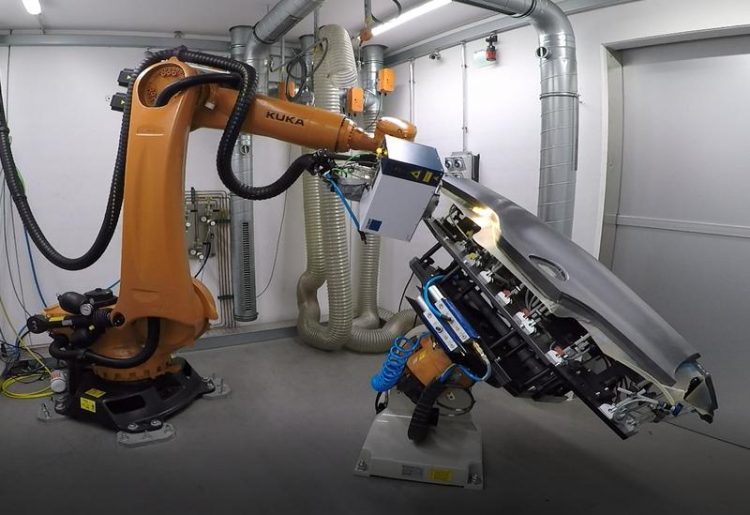Making lightweight construction suitable for series production

On the way to series production: 3D CFRP processing. Photo: LZH
Automated manufacturing processes are the basis for ultimately establishing the series production of CFRP components. In the project HolQueSt 3D, the LZH has developed processes for cutting three-dimensional components, using an actual component from the automotive branch. The process uses a newly developed high-power disc laser from the Trumpf Laser GmbH, with a pulse duration of tp = 30 ns and a maximum average output power of PL = 1500 W.
The KMS Automation GmbH has developed clamping devices which are adapted to the special features of laser material processing. An exhaust system to capture the process emissions is directly integrated in the clamping unit. The companies Volkswagen AG and INVENT GmbH have investigated the influence of laser processing on the characteristics of the component as well as on the subsequent processes.
Repairs: Scarfing curved surfaces
„Repairing three-dimensional CFRP components is presently very time-consuming and costly,” explains Sven Blümel, project manager from the Composites Group at the LZH. “We can now scarf components with curved surfaces with short process times, as a preparation for repair. Subsequently, the scarfed areas are closed with a so-called patch, an accurately fitting replacement part. This is an important step in increasing the lifetime of CFRP body parts.” This concept for the following repair steps was developed by the Institute of Polymer Materials and Plastics Engineering (PuK) of the Clausthal University of Technology.
Directly capturing process emissions
Emissions from standard processes must be known and controllable, in order to ensure a safe workplace. This is why the Safety Technology Group of the LZH has investigated the emissions from the cutting and scarfing processes. Based on the composition of the process emissions, the Jenoptik Automatisierungstechnik GmbH has developed a completely regenerative, continuously working, exhaust cleaning system that does not need additional filter material.
Applications have been the focus of the project HolQueSt. The Volkswagen AG has accompanied the complete development process. “The successful completion of the project has brought us a step closer to series production”, concluded Sven Blümel.
About HolQueSt 3D
The project „3D high-power laser processing for increasing the quality and efficiency for the reliable, automated manufacturing of CFRP lightweight construction structures” (HolQueSt 3D) was subsidized with approximately 4 million euros by the Federal Ministry of Education and Research (BMBF) within the funding initiative “Photonic Processes and Tools for Ressource-Efficient Lightweight Construction”. The project partners are Volkswagen AG, Jenoptik Automatisierungstechnik GmbH, Trumpf Laser GmbH, Invent GmbH, KMS Automation GmbH, the Clausthal University of Technology and the Laser Zentrum Hannover e.V.
Media Contact
More Information:
http://www.lzh.de/All latest news from the category: Machine Engineering
Machine engineering is one of Germany’s key industries. The importance of this segment has led to the creation of new university degree programs in fields such as production and logistics, process engineering, vehicle/automotive engineering, production engineering and aerospace engineering among others.
innovations-report offers informative reports and articles covering technologies such as automation, motion, power train, energy, conveyor, plastics, lightweight construction, logistics/warehousing, measurement systems, machine tools and control engineering.
Newest articles

Superradiant atoms could push the boundaries of how precisely time can be measured
Superradiant atoms can help us measure time more precisely than ever. In a new study, researchers from the University of Copenhagen present a new method for measuring the time interval,…

Ion thermoelectric conversion devices for near room temperature
The electrode sheet of the thermoelectric device consists of ionic hydrogel, which is sandwiched between the electrodes to form, and the Prussian blue on the electrode undergoes a redox reaction…

Zap Energy achieves 37-million-degree temperatures in a compact device
New publication reports record electron temperatures for a small-scale, sheared-flow-stabilized Z-pinch fusion device. In the nine decades since humans first produced fusion reactions, only a few fusion technologies have demonstrated…





















